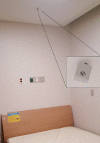Prediction of Obstructive Sleep Apnea Based on Respiratory Sounds Recorded Between Sleep Onset and Sleep Offset
- PMID: 30189718
- PMCID: PMC6315207
- DOI: 10.21053/ceo.2018.00388
Prediction of Obstructive Sleep Apnea Based on Respiratory Sounds Recorded Between Sleep Onset and Sleep Offset
Abstract
Objectives: To develop a simple algorithm for prescreening of obstructive sleep apnea (OSA) on the basis of respiratory sounds recorded during polysomnography during all sleep stages between sleep onset and offset.
Methods: Patients who underwent attended, in-laboratory, full-night polysomnography were included. For all patients, audio recordings were performed with an air-conduction microphone during polysomnography. Analyses included all sleep stages (i.e., N1, N2, N3, rapid eye movement, and waking). After noise reduction preprocessing, data were segmented into 5-s windows and sound features were extracted. Prediction models were established and validated with 10-fold cross-validation by using simple logistic regression. Binary classifications were separately conducted for three different threshold criteria at apnea hypopnea index (AHI) of 5, 15, or 30. Prediction model characteristics, including accuracy, sensitivity, specificity, positive predictive value (precision), negative predictive value, and area under the curve (AUC) of the receiver operating characteristic were computed.
Results: A total of 116 subjects were included; their mean age, body mass index, and AHI were 50.4 years, 25.5 kg/m2 , and 23.0/hr, respectively. A total of 508 sound features were extracted from respiratory sounds recorded throughout sleep. Accuracies of binary classifiers at AHIs of 5, 15, and 30 were 82.7%, 84.4%, and 85.3%, respectively. Prediction performances for the classifiers at AHIs of 5, 15, and 30 were AUC, 0.83, 0.901, and 0.91; sensitivity, 87.5%, 81.6%, and 60%; and specificity, 67.8%, 87.5%, and 94.1%. Respective precision values of the classifiers were 89.5%, 87.5%, and 78.2% for AHIs of 5, 15, and 30.
Conclusion: This study showed that our binary classifier predicted patients with AHI of ≥15 with sensitivity and specificity of >80% by using respiratory sounds during sleep. Since our prediction model included all sleep stage data, algorithms based on respiratory sounds may have a high value for prescreening OSA with mobile devices.
Keywords: Machine Learning; Obstructive Sleep Apnea; Polysomnography; Respiratory Sounds.
Conflict of interest statement
No potential conflict of interest relevant to this article was reported.
Figures



Similar articles
-
A Classifying Model of Obstructive Sleep Apnea Based on Heart Rate Variability in a Large Korean Population.J Korean Med Sci. 2023 Feb 20;38(7):e49. doi: 10.3346/jkms.2023.38.e49. J Korean Med Sci. 2023. PMID: 36808544 Free PMC article. Clinical Trial.
-
Prediction of Apnea-Hypopnea Index Using Sound Data Collected by a Noncontact Device.Otolaryngol Head Neck Surg. 2020 Mar;162(3):392-399. doi: 10.1177/0194599819900014. Epub 2020 Feb 4. Otolaryngol Head Neck Surg. 2020. PMID: 32013710
-
Evaluating Prediction Models of Sleep Apnea From Smartphone-Recorded Sleep Breathing Sounds.JAMA Otolaryngol Head Neck Surg. 2022 Jun 1;148(6):515-521. doi: 10.1001/jamaoto.2022.0244. JAMA Otolaryngol Head Neck Surg. 2022. PMID: 35420648 Free PMC article.
-
Prediction of Oxygen Desaturation by Using Sound Data From a Noncontact Device: A Proof-of-Concept Study.Laryngoscope. 2022 Apr;132(4):901-905. doi: 10.1002/lary.29971. Epub 2021 Dec 7. Laryngoscope. 2022. PMID: 34873695
-
Real-Time Detection of Sleep Apnea Based on Breathing Sounds and Prediction Reinforcement Using Home Noises: Algorithm Development and Validation.J Med Internet Res. 2023 Feb 22;25:e44818. doi: 10.2196/44818. J Med Internet Res. 2023. PMID: 36811943 Free PMC article.
Cited by
-
Enhanced machine learning approaches for OSA patient screening: model development and validation study.Sci Rep. 2024 Aug 26;14(1):19756. doi: 10.1038/s41598-024-70647-5. Sci Rep. 2024. PMID: 39187569 Free PMC article.
-
Diagnostic Modalities in Sleep Disordered Breathing: Current and Emerging Technology and Its Potential to Transform Diagnostics.Respirology. 2025 Apr;30(4):286-302. doi: 10.1111/resp.70012. Epub 2025 Mar 3. Respirology. 2025. PMID: 40032579 Free PMC article. Review.
-
A Classifying Model of Obstructive Sleep Apnea Based on Heart Rate Variability in a Large Korean Population.J Korean Med Sci. 2023 Feb 20;38(7):e49. doi: 10.3346/jkms.2023.38.e49. J Korean Med Sci. 2023. PMID: 36808544 Free PMC article. Clinical Trial.
-
Non-contact diagnosis of obstructive sleep apnea using impulse-radio ultra-wideband radar.Sci Rep. 2020 Mar 24;10(1):5261. doi: 10.1038/s41598-020-62061-4. Sci Rep. 2020. PMID: 32210266 Free PMC article. Clinical Trial.
-
The Endocannabinoid System May Modulate Sleep Disorders in Aging.Curr Neuropharmacol. 2020;18(2):97-108. doi: 10.2174/1570159X17666190801155922. Curr Neuropharmacol. 2020. PMID: 31368874 Free PMC article. Review.
References
Grants and funding
LinkOut - more resources
Full Text Sources
Other Literature Sources

